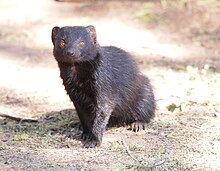| Black mongoose | |
|---|---|

| |
| Scientific classification | |
| Domain: | Eukaryota |
| Kingdom: | Animalia |
| Phylum: | Chordata |
| Class: | Mammalia |
| Order: | Carnivora |
| Suborder: | Feliformia |
| Family: | Herpestidae |
| Genus: | Herpestes |
| Species: | |
| Subspecies: | H. f. nigratus
|
| Trinomial name | |
| Herpestes flavescens nigratus | |
| Synonyms | |
|
Myonax nigratus | |
The black mongoose (Herpestes flavescens nigratus) is a subspecies of the Angolan slender mongoose occurring in Namibia and Angola. Although originally described as a separate species by Oldfield Thomas in 1928,[1] it has often been considered a subspecies of the slender mongoose (H. sanguinea). However, genetic analysis indicated that it was distinct, and it was later classified as a distinct species.[2] However, more evidence indicates that it is in fact conspecific with the Angolan slender mongoose (H. flavescens).[3]
Evidence suggests the slender mongoose and the Angolan slender mongoose, including the black mongoose, diverged around four million years ago, likely due to some populations becoming separated as the habitat in southern Africa was changing.[4] The black mongoose now occupies a distinct habitat in areas with large boulders and rocky outcrops known as inselbergs in the mountainous regions of northwest Namibia and southwest Angola.[5] After remaining in these areas for millions of years, the black mongoose is highly specialized to survive in the harsh arid environment.[4]
- ^ a b Thomas, O. (1928). "Two new S.W. African Mungooses". Annals and Magazine of Natural History. 10. 2 (11): 408. doi:10.1080/00222932808672901.
- ^ Tromp, S. (2007). "Introducing the black mongoose" (PDF). University of Queensland. Archived from the original (PDF) on 2016-03-04. Retrieved 2011-10-26.
- ^ "Explore the Database". www.mammaldiversity.org. Retrieved 2021-07-08.
- ^ a b Rapson, Sarah A. (2012). "Species boundaries and possible hybridization between the black mongoose (Galerella nigrata) and the slender mongoose (Galerella sanguinea)". Molecular Phylogenetics and Evolution. 65 (3): 831–839. doi:10.1016/j.ympev.2012.08.005. PMID 22940151.
- ^ Cite error: The named reference
:1was invoked but never defined (see the help page).